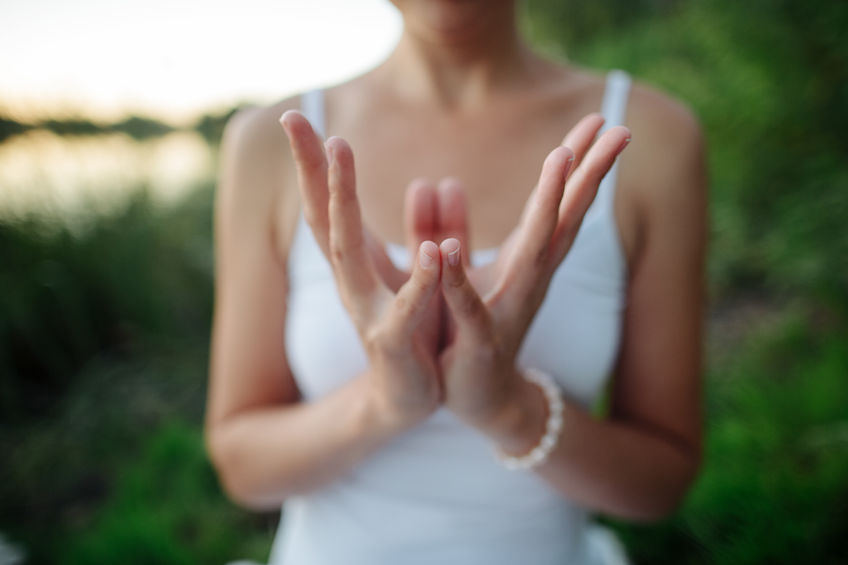Kundalini Yoga: A Great Way to Deepen Your Spirituality
Kundalini The Yoga of Awakening
By: Mary Von Ahnen, Owner, Horizon Hot Yoga
We began offering Kundalini Yoga at Horizon Hot Yoga just a few short months ago, and I realized, as students began to talk about its benefits, how little I knew about this interesting practice. I have heard it described as truly transformative, so I decided I needed to dig deeper and learn more. I read multiple articles about Kundalini and also consulted with Megan Poakeart, who in addition to being a Meditation and Kundalini teacher at Horizon Hot Yoga, is a Meditation Coach and Reiki Master. Here is what I learned.
What exactly is Kundalini yoga?
It is a combination of breath, movement, and sound. It derives from the Sanskrit word kundal, which translates to “coiled energy.” The idea is that you have energy gathered at the base of your spine and, through the practice of Kundalini, you bring that energy up your spine through the seven chakras, and out the crown of your head.
“The process of growth through Kundalini Yoga is a natural unfolding of your own nature,” Yogi Bhajan (who brought Kundalini to the West) has said. “Like a snake, you will need to shed old skins to be more of who you are.” The ultimate goal of Kundalini is to increase your self-awareness by silencing your mind and unblocking your chakras so that your vital energy can flow freely.
How has Kundalini evolved?
Kundalini yoga is an ancient practice. People in India have known its benefits for centuries. There’s a reason why the practice has gained popularity only recently: The ancient teachings of Kundalini yoga were kept secret for a very long time, only taught to royalty and nobility for thousands of years until Yogi Bhajan brought it to the West in the late 1960s and began to teach it publicly. Bhajan was well known for having mastered Kundalini at the very young age of 16. He taught thousands of classes to Westerners interested in embracing Kundalini. As so often happens, the popularity of Kundalini was also helped when celebrities like Russell Brand and Gisele Bündchen embraced it.
 What does the Kundalini practice entail?
What does the Kundalini practice entail?
A typical Kundalini yoga class consists of three parts: an opening chant (known as “tuning in”) followed by a brief warm-up for your spine, a kriya (which is a sequence of postures paired with breathing techniques), and a closing meditation or song.
Each kriya, which is Sanskrit for “action”, pairs a physical pose with a breath or meditation. These poses can be anything you choose based on the part of your body that you want to focus on, like cobra pose for your spine or frog pose for your legs and glutes.
Chanting and singing are also key components of Kundalini yoga. There are endless mantras and songs that you can recite during your practice, but most classes start with the Adi Mantra, which means “I bow to the subtle divine wisdom, the divine teacher within.” Another common chant you will hear in a Kundalini class is Sat Nam, which means “I am truth.” Kundalini classes end by chanting Sat Nam.
You can also expect a meditation-heavy class. Each set during Kundalini yoga has different poses involving movement, breathing techniques, mindfulness, and a mantra. Between postures, you will have a minute or two to relax and focus inward. After the entire set, there is a relaxation followed by a meditation, then a mantra before class closes.
As for the dress in a Kundalini class, come in loose, comfortable clothing. You may have seen Kundalini teachers and practitioners wearing white. While head-to-toe white is not required, it is common in Kundalini. That is because the color white is thought to ward off negative energy and extend your own aura. Teachers will often also wear a white head covering, such as a hat, scarf, or turban, to contain the energy within the body.
What are the health benefits?
Kundalini Yoga can have a profound effect on your physical and psychological well-being. Below are some of the most common health benefits of Kundalini.
1. Builds strength
Because you hold each posture for an extended period of time (sometimes longer than five minutes!), Kundalini yoga is a great way to strengthen and tone your muscles. Some of the more intense breathing techniques, like “Breath of Fire”, in which you breath in and out very quickly, can build core strength, as you engage your abdominal muscles with each exhale.
2. Improves your mood
That “high” you get after any yoga class is a real thing. Research has found that regularly practicing Kundalini yoga increases the production of serotonin (the happy hormone) in your brain.
3. Lowers your blood pressure and heart rate
Studies have repeatedly shown that Kundalini yoga, specifically the deep breathing techniques used during a class, can decrease the risk of hypertension. Long, slow breaths calm your autonomic nervous system and reduces stress, thus lowering both your blood pressure and pulse rate.
 4. Enhances your memory and focus
4. Enhances your memory and focus
According to research, Kundalini yoga can impact cognitive function, boosting both your concentration and memory. Even the Alzheimer’s Research and Prevention Foundation recommends a Kundalini kriya for improving memory retention.
5. Boosts your metabolism and digestive system
Through the combination of breath and postures, Kundalini yoga is focused on strengthening your core and diaphragm. This in turn improves your digestion and has been shown by researchers to speed up metabolism (meaning your body processes energy more efficiently).
Now that you have had a Kundalini primer, I’ve added Megan’s recent blog on Kundalini. I love the personal experience she shares…it enriched my understanding of Kundalini beyond just reading the basics.
“Kundalini Yoga is known as the ‘yoga of awareness’ and focuses largely on different facets of the energetic body: auric field (graduating layers of light that manage the energy outside of the body), chakras, etc. This style can be very physical, but compared to other yoga styles, the focus is less on perfecting the physical asanas (postures) and more about balancing energy within and expanding the mind and energetic field. This is a fast-acting practice, meaning I felt emotional, mental, and spiritual effects right away.
As a sober person, I appreciate that this practice brings balance to my state of mind quickly. It is the fastest way I know to calm any anxiety, resentment, fear, or ego without any outside substance and without any negative side-effects.
If you’ve ever seen any yoga pics from the ‘70s of people sticking their tongues out while in Cow Pose, with their eyes rolled up, they may have been practicing Kundalini. Among some, it has a “weird” reputation, but there is a good reason behind every posture, eye gaze, mantra, etc. Kundalini focuses on physical movements that stimulate different parts of the brain and glandular system to help us secrete helpful hormones. I have never shied away from weirdness, but if you do, I can attest to the fact it’s all for a good reason, and this really stuff works! Rarely is there anything too unusual in a Kundalini class, but in case there is, I always look at it as a great opportunity to tell my ego to take a break for an hour or so. The benefits are so worth it.
There is some different language in Kundalini yoga so I wanted to define the word ‘Kriya’ for you, as you will hear it often in this practice. The word Kriya refers to ‘action that leads to a complete manifestation’ (from The Aquarian Teacher textbook). It is a set of postures put together in order to achieve a certain outcome. On occasion, it can be just one posture or movement. There are Kriyas for everything: to relieve inner anger, to relax and release fear, to open the heart, to become intuitive… the list goes on. Two great online resources to find Kriyas are 3ho.org and spirit spiritvoyage.com
It is often recommended that you practice a meditation or Kriya for 40 days straight in order to make the practice a habit and to really reap the benefits of what that particular Kriya or meditation has to offer. I highly recommend picking one that resonates with you and trying it out for 40 days. You might consider journaling during the process to see what happens.

Megan Poakeart, Certified Kundalini Instructor
After taking Megan’s Meditation and Kundalini classes, and seeing some of her writing on Kundalini, I wanted to ask her a few questions to understand more about her journey with Kundalini.
Mary: How did you get into Kundalini Yoga?
Megan: “I got into Kundalini Yoga a couple of years ago when I was feeling a little bit spiritually stagnant and needed a change in my meditation routine. I had followed Tommy Rosen’s work with Recovery 2.0 work for a few years, which involves Kundalini yoga, but had not yet tried the techniques myself. One day I decided to try a morning meditation routine (known as ‘Sadhana’) and I felt an immediate connection. An intense drive came over me to learn as much as I could and I’ve been studying and teaching these techniques ever since.”
Mary: Who can benefit from Kundalini Yoga?
Megan: “Kundalini yoga is for everyone who likes transformation, growth and change.”
Mary: Besides the health benefits already described in the article, what are some benefits you have personally experienced?
Megan: “In my experience, the most profound benefit of the Kundalini practice is spiritual growth. I define spiritual growth for myself as an increased connection with God as I understand God, my soul and my intuition. I have become less reactive and some negative thought patterns and habits have dissolved. It has made me more resilient, discerning and trusting of myself.”
Mary: I have heard Kundalini builds intuition. How does this happen?
Megan: “I believe that any practice that requires you to sit in meditation is intuition-building because it forces you to get quiet and go within. In my own experience, when I am running around from thing to thing, there is no space for my intuition. When I take the time each day to dedicate to my spiritual practice, I’m fine-tuning my intuition skills. My definition of intuition is connection with that divine part of me that has the answers. So, there are lots of different modalities that can help you achieve this but Kundalini is my favorite because it also focuses on the chakras, the aura, as well as the pituitary and pineal glands inside the brain.”
It is tough to summarize what is obviously a complex and very deep practice. From what I’ve learned from my research and from Megan, this particular style of yoga is especially good for people who are looking for a spiritual practice as much as they’re looking for a physical workout. With the fast and profound transformations that people report, it’s clear why Kundalini Yoga has seen such a rise in popularity.
Contact Megan Poakeart:
You can find her on Instagram @zenzeroyoga and at www.meganpoakeart.com. Megan also runs the Instagram page @northtexaskundalini
About the Author:
Mary Von Ahnen is Co-Owner of Horizon Hot Yoga in Frisco. The studio offers an array of classes and meditations including Kundalini for everyone. They currently have amazing specials. Find their schedule of classes at www.horizonhotyoga.com









